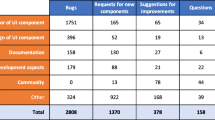Abstract
It is well known that the choice for an appropriate design strategy is an important factor in the success of a systems development project. However, the selection of a design strategy is often not carried out in a systematic way. Moreover, it is not always clear in what situation a particular design strategy is appropriate. Finally, sometimes none of the currently existing design strategies is appropriate. Consequently, there is a need to develop a strategy that is geared towards a particular project situation. In this paper we show how the selection of an existing design strategy can be carried out in a systematic way and how new design strategies can be developed. We do so by analysing the structure of design strategies and by showing how the different settings of strategy parameters can be used to reduce the risks of a particular project situation. We conclude with a description of the application of our method to a real design project.
Similar content being viewed by others
References
Boehm, B.W. (1988). A spiral model of software development and enhancement. IEEE Computer, May, 61-70.
Davis, A.M., Bersoff, E.H. and Comer, E.R. (1988). A strategy for comparing alternative software development life cycle models. IEEE Transactions on Software Engineering, 14-10, 1453-1461.
Royce, W.W. (1970). Managing the development of large software systems: concepts and techniques. Proceedings WESCON 1970. Reprinted in Proceedings of the 9th International Conference on Software Engineering, 1987 (IEEE Computer Society Press, Los Alamitos, CA) pp. 328–338.
Hirsch, E. (1985). Evolutionary acquisition of command and control systems. Program Manager, Nov-Dec, 18–22.
Schot, J. (1992). The role of Architectural Semantics in the formal approach of Distributed Systems Design. PhD thesis, University of Twente, Enschede, The Netherlands.
Wohlin, C. (1994). Managing software quality through incremental development and certification. In M. Ross, C.A. Brebbia, G. Staples and J. Stapleton (eds), Software Quality Management II, Vol. 2, Building Quality into Software (Proceedings of the Second International Conference on Software Quality Management) (Computational Mechanics Publications, Southampton, UK) pp. 186–202.
Alexander, L.C. and Davis, A.M. (1991). Criteria for selecting software process models. In G.J. Knafl (ed), The Fifteenth Annual International Computer Software & Applications Conference, (IEEE Computer Society Press, Los Alamitos, CA) pp. 521–528.
Luqi, R. (1989). Software evolution through rapid prototyping. IEEE Computer, 22-5, 13-25.
McCraken, D.D. and Jackson, M.A. (1982). Life cycle concept considered harmful. ACM Software Engineering Notes, April 29–32.
Balzer, R.M. (1985). A 15 year perspective on automatic programming. IEEE Transactions on Software Engineering, SE-11, Nov., 1268–1357.
Partsch, H. and Steinbruggen, R. (1983). Program transformation systems. ACM Computing Surveys, 15-3, 199–236.
Vissers, C.A., Ferreira P.L. and Quartel, D.A.C. (1995). The design, of telematics, systems. Lecture Notes, University of Twente Enschede, The Netherlands.
Boehm, B.W. and Papaccio, P.N. (1988). Understanding and controlling software costs. IEEE Transactions on Software Engineering, 14-10, 1462–1477.
Author information
Authors and Affiliations
Rights and permissions
About this article
Cite this article
De Wegner, M.K., Franken, H.M. A situational approach to design strategies. Software Quality Journal 6, 181–194 (1997). https://doi.org/10.1023/A:1018512002527
Issue Date:
DOI: https://doi.org/10.1023/A:1018512002527




